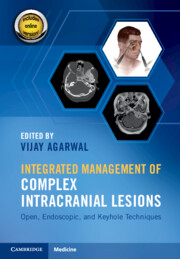Book contents
- Integrated Management of Complex Intracranial Lesions
- Integrated Management of Complex Intracranial Lesions
- Copyright page
- Dedication
- Contents
- Contributors
- Foreword
- Section I Endoscopic Endonasal (EN) Combined Approaches
- Section II Open Combined Approaches
- Chapter 6 Combined Transcranial Approach for Tumor Resection and Anterior Circulation Vascular Bypass
- Chapter 7 Hybrid/Combined Strategies for Vestibular Schwannomas
- Chapter 8 Transchoroidal, Subchoroidal, and Combined Approaches to the Third Ventricle
- Chapter 9 Combined Orbitofrontal Craniotomy and Direct Orbital Decompression
- Chapter 10 Transbasal and Transfacial Approach for Paranasal and Anterior Cranial Fossa Tumors
- Chapter 11 Combined Middle Fossa Craniotomy and Mastoidectomy for Cerebrospinal Fluid Leak Repair and Encephalocele Resection
- Chapter 12 Transcochlear and Extended/Combined Transcochlear Approaches for Complex Tumors of the Skull Base and Posterior Cranial Fossa
- Chapter 13 Combined Retrosigmoid and Orbitozygomatic Approach
- Chapter 14 Combined Retrosigmoid and Limited Anterior Petrosectomy (“Reverse Petrosectomy”)
- Chapter 15 Combined Suboccipital Craniotomy and Neck Dissection
- Chapter 16 Combined Petrosal Approach
- Chapter 17 Combined Keyhole Paramedian Supracerebellar-Transtentorial Approach
- Chapter 18 Combined Multi-portal “Pull-Through” Keyhole Craniotomy
- Chapter 19 Combined Keyhole Craniotomies for Multifocal or Multiple Lesions
- Chapter 20 Combined Microsurgical and Endovascular Treatment of Cerebrovascular and Skull Base Pathology
- Chapter 21 Combined Transsylvian-Subtemporal Approach to Anterior Circulation and Basilar Apex Aneurysms
- Index
- References
Chapter 11 - Combined Middle Fossa Craniotomy and Mastoidectomy for Cerebrospinal Fluid Leak Repair and Encephalocele Resection
from Section II - Open Combined Approaches
Published online by Cambridge University Press: 05 October 2021
- Integrated Management of Complex Intracranial Lesions
- Integrated Management of Complex Intracranial Lesions
- Copyright page
- Dedication
- Contents
- Contributors
- Foreword
- Section I Endoscopic Endonasal (EN) Combined Approaches
- Section II Open Combined Approaches
- Chapter 6 Combined Transcranial Approach for Tumor Resection and Anterior Circulation Vascular Bypass
- Chapter 7 Hybrid/Combined Strategies for Vestibular Schwannomas
- Chapter 8 Transchoroidal, Subchoroidal, and Combined Approaches to the Third Ventricle
- Chapter 9 Combined Orbitofrontal Craniotomy and Direct Orbital Decompression
- Chapter 10 Transbasal and Transfacial Approach for Paranasal and Anterior Cranial Fossa Tumors
- Chapter 11 Combined Middle Fossa Craniotomy and Mastoidectomy for Cerebrospinal Fluid Leak Repair and Encephalocele Resection
- Chapter 12 Transcochlear and Extended/Combined Transcochlear Approaches for Complex Tumors of the Skull Base and Posterior Cranial Fossa
- Chapter 13 Combined Retrosigmoid and Orbitozygomatic Approach
- Chapter 14 Combined Retrosigmoid and Limited Anterior Petrosectomy (“Reverse Petrosectomy”)
- Chapter 15 Combined Suboccipital Craniotomy and Neck Dissection
- Chapter 16 Combined Petrosal Approach
- Chapter 17 Combined Keyhole Paramedian Supracerebellar-Transtentorial Approach
- Chapter 18 Combined Multi-portal “Pull-Through” Keyhole Craniotomy
- Chapter 19 Combined Keyhole Craniotomies for Multifocal or Multiple Lesions
- Chapter 20 Combined Microsurgical and Endovascular Treatment of Cerebrovascular and Skull Base Pathology
- Chapter 21 Combined Transsylvian-Subtemporal Approach to Anterior Circulation and Basilar Apex Aneurysms
- Index
- References
Summary
Lateral skull base meningoencephalic herniations (MEH) are rare instances where dura mater (meningocele) or cerebral tissue (encephalocele) protrudes through skull base dehiscences, commonly in the tegmen tympani or mastoidium. Encephaloceles and cerebrospinal fluid (CSF) leaks carry great risk, as they provide a potential pathway from the middle ear to the subarachnoid space. Patients often present with non-specific clinical symptoms, so a high degree of clinical suspicion is needed, with a thorough radiologic assessment to confirm the diagnosis and location of bony defects. Early detection and surgical repair of encephaloceles or CSF leaks are imperative. Typical surgical approaches for lateral skull base encephaloceles are based on surgeon experience and include the transmastoid (TM), middle cranial fossa (MCF), and combined TM and MCF approach. In general, the TM approach is used for small defects, and for larger defects, the MCF or combined approach is typically the procedure of choice. When there is no possibility of hearing preservation or rehabilitation, a middle ear obliteration (MEO) can be considered as it has very low recurrence rates and provides definitive treatment. Our institution prefers the combined transmastoid and keyhole middle cranial fossa approach.
Keywords
- Type
- Chapter
- Information
- Integrated Management of Complex Intracranial LesionsOpen, Endoscopic, and Keyhole Techniques, pp. 111 - 121Publisher: Cambridge University PressPrint publication year: 2021



